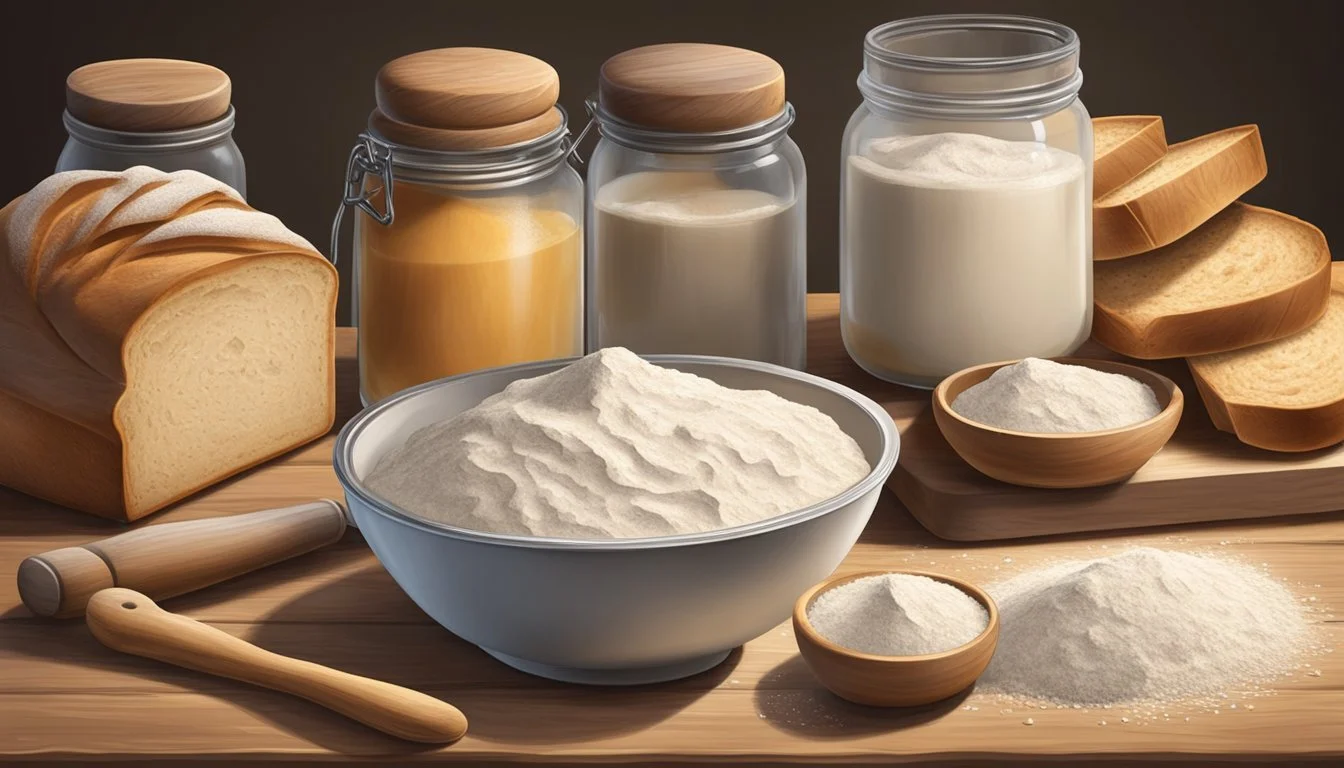Sourdough Baking in Literature
Uncovering Bread's Role in Classic Novels
Sourdough baking has long been an esteemed tradition, its complexity and depth often serving as a metaphor for life's intricate processes in literature. As a staple of human diet, the art of breadmaking extends beyond mere sustenance, symbolizing nourishment, community, and the passage of time. Classic novels frequently allude to the ritualistic aspect of breadmaking, where the physical act of kneading dough and the patience required for it to rise echo the toil and perseverance evident in character development and narrative progression.
In many respects, sourdough bread (What wine goes well with bread?) embodies a blend of science and magic, with each loaf signifying a unique intersection of culture, environment, and method. This distinctiveness of sourdough in literature mirrors the individuality of characters and settings, allowing authors to imbue a sense of place and history within their stories. The alchemy of sourdough—flour, water, and salt transformed by wild yeast and bacteria—parallels the transformative journeys that characters undergo, thus enhancing the reader's engagement with a narrative's underlying themes.
This longstanding relationship between sourdough, baking, and narrative craft not only enriches the tapestry of storytelling but also reflects the shared human experience across time and cultures. Exploring how the process of sourdough baking is woven into classic literature reveals how this beloved culinary tradition has been utilized to deepen narratives and connect readers to the age-old human experience of breaking bread.
The Role of Sourdough in Classic Literature
Sourdough baking holds a notable place in literature, often used to enrich narratives with its rich symbolism and historical significance.
Symbolism of Bread in Novels
In many classic novels, bread, and by extension sourdough, represents the fundamental aspects of life such as sustenance, community, and tradition. It can signify prosperity, as well as privation, reflecting the socio-economic status of characters. For example, bread in Victor Hugo’s "Les Misérables" underlines the dire poverty of the characters, juxtaposing their hunger with the broader themes of injustice and social disparity.
Sourdough Depictions across Different Cultures
Classic literature portrays sourdough in various cultural contexts, highlighting its universal presence across geographies. Persian literature, for instance, infuses poetry with references to bread, using it as a metaphor for fulfillment and companionship, as seen in the excerpt where a simple meal of bread and wine becomes a moment of paradise in the wilderness. Not only does it depict everyday life, but it also binds different ages and societies, showing the continuity of baking traditions.
Historical Context of Sourdough in Literature
The historical context of sourdough in literature extends to its role in communal and domestic settings. Ancient texts may not mention the term 'sourdough' explicitly, but the fermented bread has been a dietary staple for millennia, featuring in writings that date back thousands of years. Its representation in literature often informs readers about the culinary practices of the time and serves as a lens through which to examine past livelihoods and societal norms.
Fundamentals of Sourdough Baking
Sourdough baking encompasses the careful management of a living culture and precision in ingredient ratios to create a rich, flavorful loaf. The process hinges on understanding the key components and their functions.
Understanding Sourdough Starter
A sourdough starter is a mixture of flour and water inhabited by wild yeast and bacteria. The starter's health is paramount, and it requires regular feeding—consisting of both flour and water—to maintain its vitality. Flour choices like white flour, bread flour, or whole wheat flour can influence the starter's activity. The starter should exhibit a balance between acidity and yeasty fragrance, signaling readiness for baking.
The Science of Sourdough Fermentation
During fermentation, wild yeast converts sugars in the flour to carbon dioxide and alcohol, while the bacteria produce lactic and acetic acids, contributing to sourdough's distinctive taste. The length of fermentation affects the bread's flavor and texture—the longer the ferment, the more complex the flavor. Hydration, the ratio of water to flour, plays a crucial role in this process. The typical hydration level ranges from 65% to 85%, with higher hydration leading to a more open crumb and lighter texture.
Importance of Ingredients Ratio
The ratio of ingredients in sourdough bread is essential for achieving the desired outcome. Basic sourdough consists of:
Starter: The leavening agent, typically using a small proportion relative to the total flour weight to regulate the rise.
Flour: Provides structure; all-purpose flour is versatile, while bread flour yields a stronger, chewier crumb.
Water: Dictates hydration; affects dough extensibility and final bread texture.
Salt: Enhances flavor and regulates yeast activity, with a common ratio being around 2% of the flour's weight.
Each ingredient interacts with others, making precision and balance non-negotiable in sourdough baking.
Sourdough Techniques in Baking
Mastering sourdough baking requires a thorough understanding of specific techniques that affect the bread's flavor, crumb, and crust. From mixing and proofing to baking, implementing the right methods is crucial for creating the perfect sourdough loaf.
Mixing and Proofing Methods
Sourdough baking begins with the mixing of ingredients, which typically includes flour, water, salt, and an active sourdough starter. The proportions and temperature of these ingredients are vital to the hydration level and overall flavor profile of the bread. Most sourdough recipes utilize a process called autolyse, where flour and water combine before adding salt and starter. This period of rest aids in gluten development without the need to knead, favoring high hydration doughs that create an open crumb.
Proofing is the next critical phase where dough must rise. Sourdough generally undergoes a bulk fermentation, followed by a final proof. Proper proofing times and temperatures ensure a good rise and affect the bread's flavor and crumb structure.
Shaping and Scoring Dough
Once dough has completed its bulk ferment, it is shaped, which helps in building the right structure and tension for baking. Shaping techniques differ depending on the desired outcome, but common methods include gentle rounding and folding to maintain the dough's delicate structure.
Scoring is done just before baking, creating shallow cuts on the surface of the dough with a sharp blade. Scoring controls the expansion of the loaf while baking, contributing to the perfect crust. The pattern and depth of the scores can affect the bread's final appearance and crust characteristics.
Baking in a Dutch Oven
Baking sourdough in a Dutch oven has become a popular technique due to its ability to mimic a professional steam oven. The enclosed space captures the steam released from the dough, a crucial element for achieving a glossy, well-risen crust with ideal texture. The no-knead method is particularly well-suited to Dutch oven baking, where high hydration doughs benefit from the contained environment, fostering the right conditions for an optimal crust and tender crumb.
To bake, the Dutch oven is preheated with the oven, and the dough is carefully placed inside. The lid is then placed back on to trap steam. After a period, the lid can be removed to allow the crust to achieve a rich, golden color and perfect crust.
Exploring Sourdough Recipes from Classic Texts
As literature offers a window into the past, it reveals that sourdough has long been a staple in gastronomic storytelling. This section uncovers the role of sourdough in classic texts, examining specific recipes and culinary methods the characters might have used.
Sourdough Loaf Recipes
Classic novels often depict sourdough bread as a symbol of sustenance and the baker's art. One might imagine a character carefully preparing a starter with equal parts flour and water, allowing it to ferment and capture the wild yeasts from the air. They'd mix this with more flour and water to bake a homemade sourdough loaf, described as a rustic and hearty bread with a tangy flavor profile. The process can be an artful reflection of the time taken to develop characters in a novel.
Sourdough in Soups and Sauces
In literature, sourdough often accompanies meals, enhancing flavors and adding depth to simple dishes. Characters would tear off pieces of dense, freshly baked sourdough bread to dip into rich, robust soups. One can even envision sauces thickened with sourdough starter, a technique that not only utilizes the entire product but also imparts a subtle tang and body to the dish, indicating resourcefulness and ingenuity.
Creative Uses of Sourdough in Desserts
While not as common as the iconic loaf, sourdough in desserts appears in narratives as a unique twist to conventional sweets. Culinary passages might describe the addition of sourdough to a chocolate cake, offering an unexpected yet delightful tang and improving the texture. The inclusion of sourdough pizza in a text could showcase characters experimenting with fermented dough to achieve a lighter, crispier crust, displaying innovation in their cooking methods.
Cultural Significance of Sourdough
Sourdough has been a cornerstone in culinary traditions and has woven itself into the fabric of society. It is not merely food; it's a symbol deeply embedded in cultural heritage.
Sourdough in Everyday Life
In many cultures, sourdough transcends its role as mere sustenance. It stands as a testament to the resilience and resourcefulness of people. Historically, the ability to create bread from simple ingredients like flour and water highlighted a household's self-sufficiency. Families would maintain sourdough starters—basically a fermenting mixture of flour and water—that were often passed down through generations, with each bringing their unique flavor and character to the bread. Such starters held a significant place in everyday life, acting as the lifeline of their bread-making process.
Maintenance: Maintainers must feed their starters regularly with fresh flour and water, building a daily ritual into their routine.
Sharing: Sourdough starters are frequently shared among friends and neighbors, symbolizing community and continuity.
Sourdough as a Symbol of Sustenance
Sourdough bread is a powerful symbol of nourishment and survival. It is well-regarded for its nutritional benefits and has been a fundamental food item across various socio-economic backgrounds. The fermentation process, pivotal in sourdough making, is known to enhance digestion and improve the availability of nutrients. This made sourdough a reliable dietary staple when refined foods were inaccessible or unaffordable for many. Moreover, sourdough differs from other flatbreads due to its unique tanginess and texture, which comes from the lactic acid produced during fermentation—a feature that establishes its distinct place on the table.
Flatbreads vs Sourdough: While flatbreads can be made quickly without leavening, sourdough's fermentation allows for a richer flavor and texture, making it a special form of bread.
Health Aspects: The lactobacilli in sourdough starters break down phytates, making the bread easier to digest and its nutrients more bioavailable.
Sourdough Baking Tips and Tricks
Mastering sourdough baking involves understanding the nuances of crust and crumb formation, keeping the starter active and healthy, and managing dough with high hydration levels. This section underscores specialized techniques to elevate one's sourdough bread baking.
Achieving the Ideal Crust and Crumb
To attain a crisp crust and chewy crumb, controlling oven temperature is crucial. Bakers should preheat a stoneware or hot dutch oven which mimics a professional oven's heat distribution. The stoneware provides a consistent high heat that contributes to a robust oven spring—the phase in baking where bread expands rapidly. Additionally, minimal kneading allows gluten networks to form slowly, giving sourdough its characteristic chewy texture.
For an optimal crust, maintaining steam within the first 15 to 20 minutes of baking is key. This can be achieved by introducing a pan of hot water at the bottom of the oven or spraying the oven walls to create a moist environment. A bubbly starter and a sprinkle of sea salt over the dough can enhance flavor and improve crust formation.
Maintaining an Active Sourdough Starter
A sourdough starter thrives on regular feedings of flour and lukewarm water. It should have a fresh, pleasant aroma and appear vibrant and bubbly, indicating a high count of yeast and beneficial bacteria. To evaluate health, the starter should double in volume approximately within 6 to 8 hours after feeding.
Bakers use an instant-read thermometer to ensure water is at the correct temperature to activate the yeast without damaging it. Feeding intervals and flour types can be adjusted based on ambient temperature and desired sourness, with high-protein or whole grain flours often used to sustain a robust starter.
Baking at High Hydration Levels
High hydration doughs, featuring a higher water-to-flour ratio, result in bread with an open crumb and light texture, but they can be more challenging to handle. Central to managing high hydration doughs is a series of folds, as opposed to kneading, to develop the gluten structure. This approach incorporates air and aligns the dough's starch chains to strengthen the gluten networks without overworking it.
The balance of water absorption and the strength of the flour determines the success of a high hydration loaf. Flours with a strong gluten index are preferred, and it's essential to adjust hydration levels according to the flour’s absorption capacity, considering different brands, such as Central Milling, may have distinct wheat qualities. Using a technique such as autolyse, where flour and water are combined and rested before adding other ingredients, can significantly improve dough structure and final bread quality.








